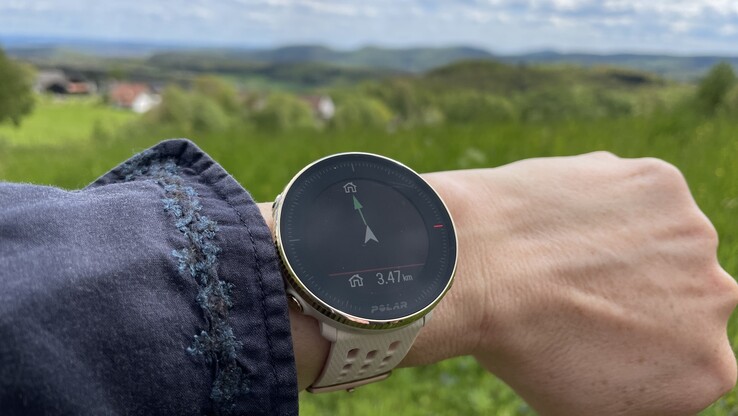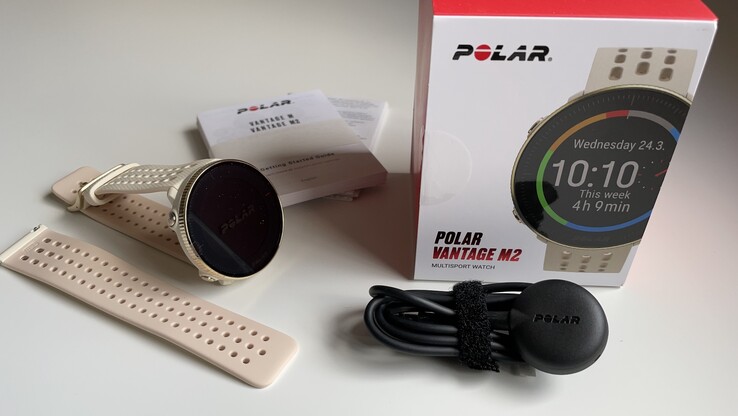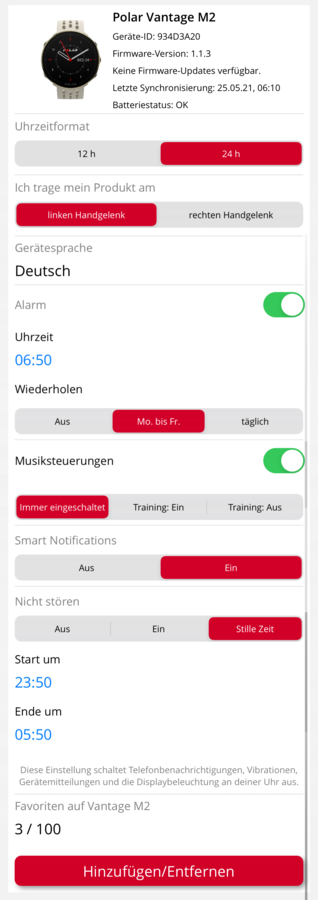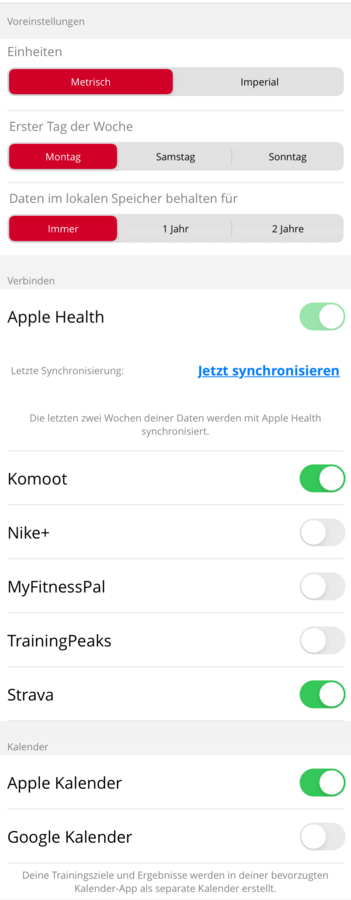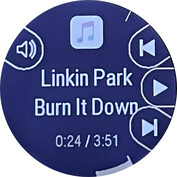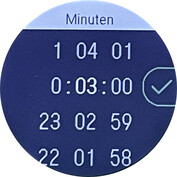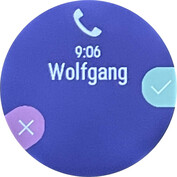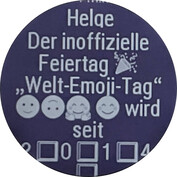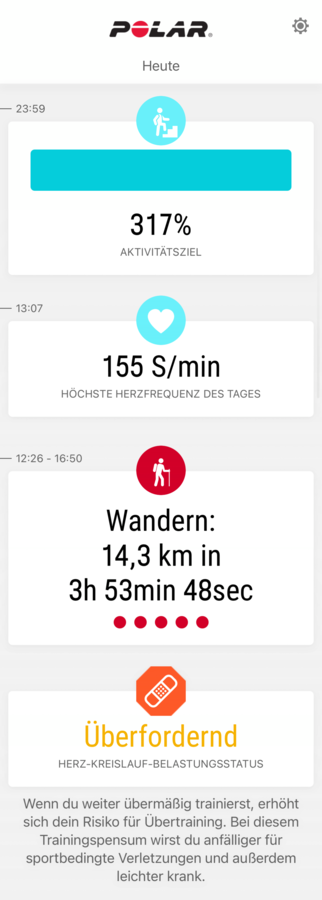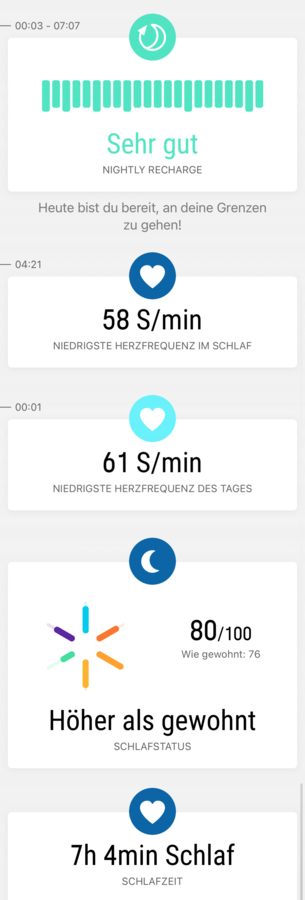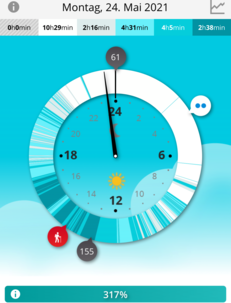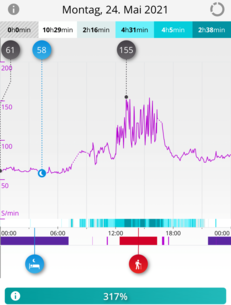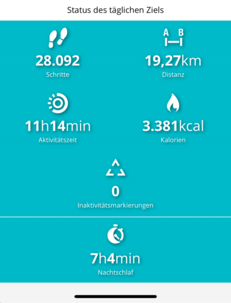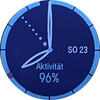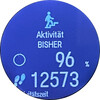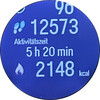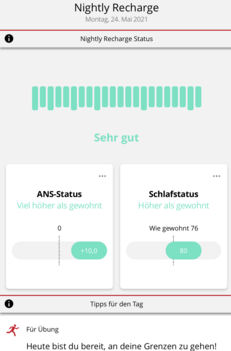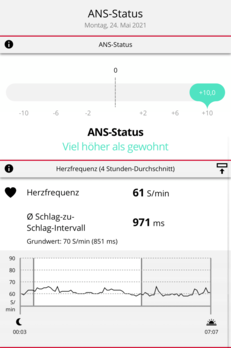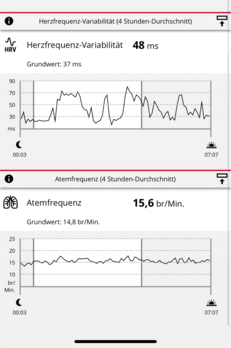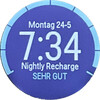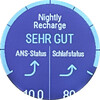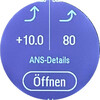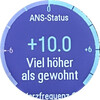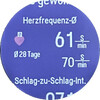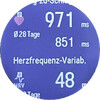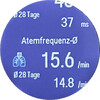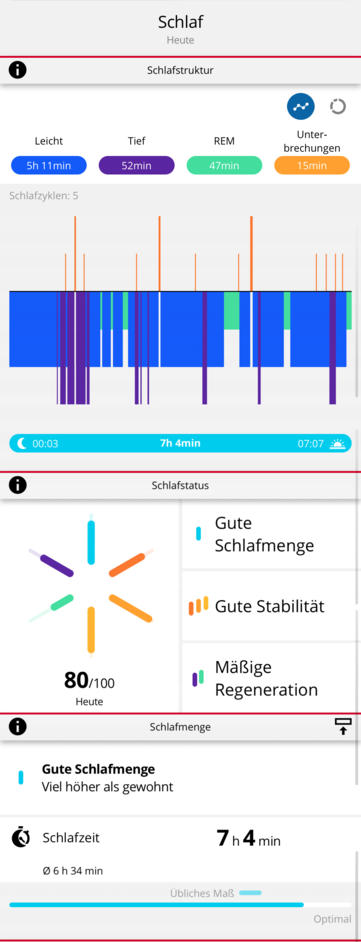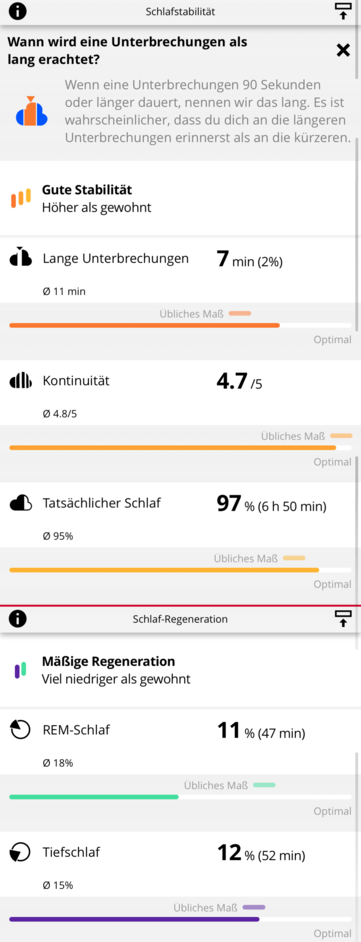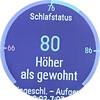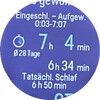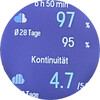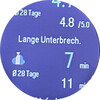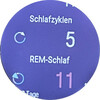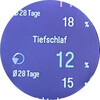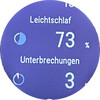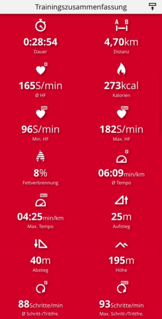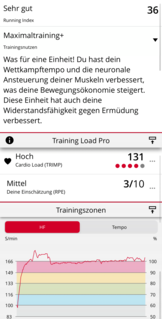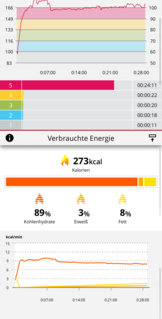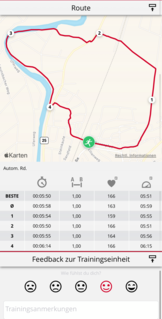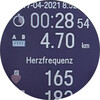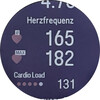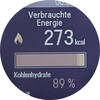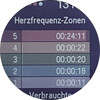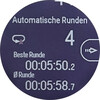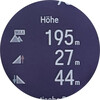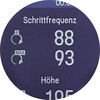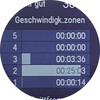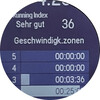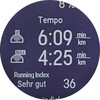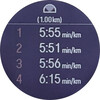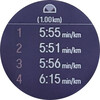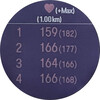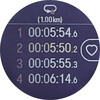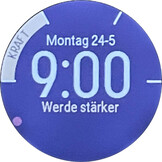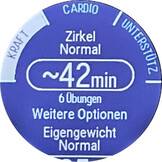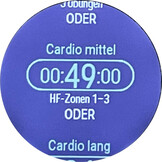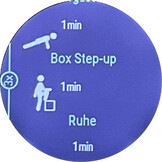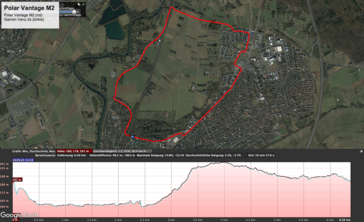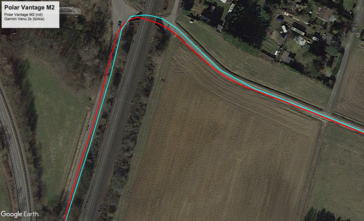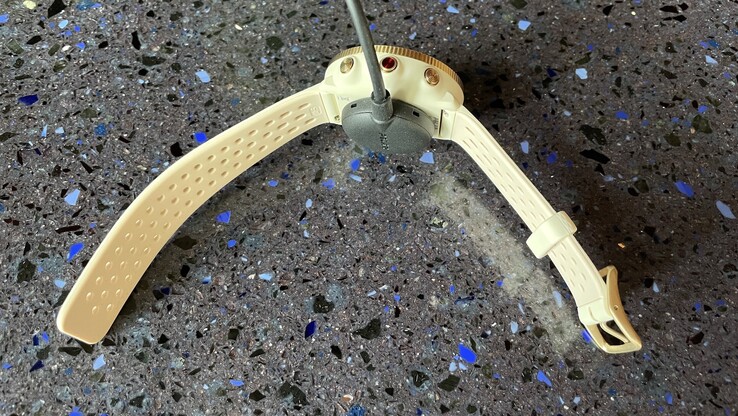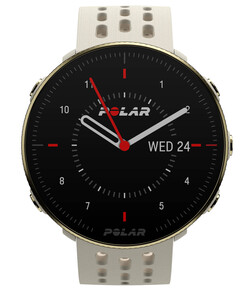Polar Vantage M2 smartwatch in review: Good sports functions, still without touchscreen
Case and features - With multi-band GPS
The Polar Vantage M2 follows the Vantage M introduced in 2018, which Polar introduced at the same time as the Vantage V at the time. Even then, the Vantage V had a touchscreen and barometer while the Vantage M didn't, and that hasn't changed in the 2nd generation.
The case of the Vantage M2 is made of fiberglass-reinforced polymer. On the silicone strap, we like the clasp, which, like the bezel, is made of stainless steel and has an additional bracket. This allows the strap to be threaded more quickly than through the usual first of two loops behind the clasp. The two included band pieces cover a wrist circumference of 130-210 mm (5.1-8.3 in).
In contrast to the Vantage V2, the Vantage M2 has not undergone MIL-STD-810G testing. Instead of laminated Gorilla glass, a PMMA laminated glass with a tempering coating is used. Polar specifies the water protection at 30 m (~98 feet) according to ISO 22810 and adds "minimum for bathing and swimming" in the wording; the Vantage V2 is protected to 100 m (~328 ft) according to the same standard and is suitable for regular use in water - but not for diving with equipment.
The signal generator with which the Vantage V2 acoustically amplifies vibration alerts, is missing from the Vantage M2, as is an ambient light sensor to adjust the brightness of the 1.2-inch display. The brightness cannot be changed manually. Although the LCD is easy to read in daylight, the backlight, which is activated when the arm is raised, is often not sufficient indoors. The stronger light, which is turned on with the upper left button, is sufficient.
A long press on the same button locks the other 4 against unintentional triggering of functions. They can be used to start the synchronization with the smartphone and navigate through the menus. A long press on the middle right button opens the training app in the last used training mode. The buttons only have a weak pressure point. Polar enhances the haptic feel with a slight vibration.
Setup and operation - optionally with or without smartphone
Both Polar watches do not necessarily require a smartphone. They can just as well be set up via a computer or used independently. Basic data such as gender, age, height and weight, as well as training intensity and the usual sleep time are entered directly via the watch in this case.
If you want to connect it to an iPhone or an Android smartphone, you download the Polar Flow app from the respective store, which also provides firmware updates to the Vantage M2.
There is no watch face store like in other smartwatches; instead, there are only four analog and four digital variants with additional color options for the time display.
Polar adds different information to the watch face, similar to widgets. Using the navigation buttons, you can switch between them or open detailed pages, such as weather, activity status, last workout, or Polar analytics like Cardio Load Status and Nightly Recharge, which the Health and Fitness section explains.
Weather info includes actual and felt temperature, precipitation and humidity, wind speed and direction, and a 2-day weather forecast. The forecast is hourly for the following 12 hours. After that, or for the following day at the latest, the rhythm changes to a three-hourly forecast, and for the day after next, to 6 hours.
The last widget names the title that the smartphone is currently playing and opens a remote control for its player if required.
Optionally via the app or the watch itself, you can set an alarm that repeats on individual days. However, there are no other alarms for alternative times and repetition rhythms. Furthermore, tools like the timer or stopwatch can only be accessed via the menu, so comparatively many buttons have to be pressed before the time starts running.
Telephony and notifications
Incoming calls can be rejected or accepted and then made via the smartphone.
Notifications often arrived with a long delay. The Vantage M2 also displays longer texts, but not always in full text depending on the volume. Emojis appear monochrome.
Health and fitness - workout suggestions from Polar
The Polar Flow app can transfer the smartwatch's data to Apple Health, but not to Google Fit. Through the app, you can connect your Polar account to Strava, Komoot, TrainingPeaks, MyFitnessPal and Nike+ to view your activities in Strava, for example. Unlike the Polar Vantage V2, Strava Live segments and Komoot routes cannot be transferred to the Vantage M2.
The FuelWise function adds intelligent reminders for food and fluid intake to the usual inactivity alarm of fitness trackers. FuelWise adapts the carbohydrate requirement to the personal data and the training workload.
While the fitness watch separates health and exercise data, the iPhone app gathers it into a daily dashboard.
Activity and health monitoring
Instead of calories burned or steps taken, Polar asks about physical exertion at work and during sports and uses this to determine a level for the activity target. The health tracker provides the respective status via the activity widget; the app visualizes the movement intensity by color: Dark colors stand for high activity, light colors for low activity.
Heart rate, heart rhythm and blood oxygen saturation
The Polar Vantage M2 does not log blood oxygen saturation (SpO2). It measures the heart rate around the clock or only at night if desired. You can deactivate the measurement during training.
We determine the potential of the optical heart rate monitor under the dynamic conditions of an interval workout, which we record simultaneously with a heart rate sensor. The PPG sensor of the Vantage M2 clearly lags behind the chest strap. The maximum heart rate is only nine beats below the chest strap's value, but the Vantage M2 is 19 beats below it in the phase when the chest strap reaches its maximum. That is clearly too little, especially since it does not signal the higher frequency in the following minutes.
Sleep recording and nightly recovery
If you also wear the watch at night, Polar splits the recording into two areas. The ANS status provides information on heart rate, breathing rate and heart rate variability. By recording this data, Polar analyzes how well the autonomic nervous system (ANS) has recovered overnight in order to make recommendations for training the next day.
Separately, Polar looks at sleep phases and classifies them based on records of past nights.
Training recording
The Polar Flow app lets you decide which of the 130 possible sports programs, including those of the streaming provider Les Mills, should be available on the Polar Vantage M2. You can also personalize the training screen and individual parameters via the app.
The sports tracker records a maximum of 20 training programs, supplemented by favorites that are also created via Polar Flow. By the way, Polar's web portal at flow.polar.com is recommended for easy configuration and later analysis.
Polar differentiates between quick and phase targets in the favorites. Quick targets either aim for a defined calorie consumption or a time or distance target. Phase targets are used to define an interval training, optionally with warm-up and cool-down. Using the phase target or the ZoneLock function, you can define a power, speed or heart rate zone that you want to reach or maintain. Zone changes are signaled by the Vantage M2 via vibration during the workout.
Simple interval and countdown timers can also be set on the watch itself. If you want to run or ride a given distance in a fixed time, the Vantage M2, like the Vantage V2, determines a race-pace and visualizes it during the workout. What the Vantage M2 is missing compared to the Vantage V2 is the Hill Splitter function: The Vantage V2 uses the altitude sensor to distinguish between flat stretches and sections with a downhill or uphill gradient and calculates the average speed for all three cases.
If you are interested in the Hill Splitter function, you should take a look at the test of the Polar Vantage V2 test. The training log included there comes from the same run as the one of the Vantage M2 shown here. The watches were not on the same wrist, as correctly indicated in the app.
After each workout, Polar uses the Cardio Load status to evaluate the load of the workout on the cardiovascular system. The associated Cardio Load widget signals whether the current training intensity is underwhelming, sustaining, building, or overwhelming. In testing, the status at least reflected well when the author overdid herself with interval workouts.
Based on this, the FitSpark widget provides personalized workout suggestions that include supportive exercises as well as guided cardio or strength workouts.
The test results for the Polar Vantage V2 described in the review of the Polar Vantage V2 are not available on the Vantage M2. However, it can also be connected to running and cycling sensors, as well as an external sensor for heart rate.
GPS and navigation
The Polar Vantage M2 recognizes the navigation satellite systems GPS, Galileo, GLONASS and QZSS and always connects simultaneously in pairs with GPS and one of the other three.
On a bike tour with the Vantage M2 and the Venu 2s from Garmin the track of the two is close to each other, both hardly intersect the path anywhere. TheVantage M2 gets the altitude via GPS.
If you enable the back-to-start option during an outdoor activity, such as a hike, it shows the direction and distance to the starting point on an additional screen during the activity, as seen in the image at the top.
Unlike the Vantage V2, however, you can't transfer Komoot routes or Strava Live segments to the Vantage M2. If you want to spare the battery, you extend the recording interval from 1 second to 1 or 2 minutes or deactivate GPS.
Runtime - Smaller battery than the Vantage V2
Polar states a runtime of up to 30 hours for the training mode with GPS and wrist-based heart rate measurement. We find different specifications from Polar for normal smartwatch operation with continuous heart rate measurement. We received 5 days from the manufacturer as a guideline. In the test, the setup corresponded to the factory settings with the exception of notifications, which it only received during the day. In this setting, the 230 mAh battery ran for 6 days including two half-hour workouts in GPS mode. Deactivating the notifications completely or limiting the heart rate measurement to nighttime can save the battery even more.
It took one and a half hours to charge in the test.
Pros
Cons
Verdict
The Polar Vantage M2 has clear gaps in the overall picture. The brightness, for example, neither adjusts itself nor can it be changed manually. Whether you need touch control or not - not offering it is not up to date. Where 2-3 movements are often enough to activate the timer, display messages or mute notifications, you need much longer with the Vantage M2. Muting, for example, requires 9 steps, the timer at least 11. However, a bit of software is still required, because the Vantage V2 with touchscreen takes longer for some functions than a conventional smartwatch.
Neither of them measure blood oxygen saturation - even inexpensive watches do that reliably enough by now. And without detailed knowledge, the separation of sleep phases and respiration is less clear than the charts from Garmin, Fitbit or Huawei, where users can partially overlay sleep phases, respiration, oxygen saturation and exercise.
With the specific new performance tests of the Polar Vantage V2, the Vantage M2 cannot compare. However, its MSRP is also 200 Euros (~$244) lower.
For athletes, the Polar Vantage M2 offers many good features more affordably than the Polar Vantage V2.
These include the personalizable training screens, individual quick and phase targets, and focused training in a targeted power, speed, or heart rate zone. However, the Vantage M2's heart rate measurement is not the most reliable under load, as our test proves.
Other plus points include multi-band GPS with high precision and back-to-start bearing navigation. In terms of navigation, the Venu 2 from Garmin does not offer much more in terms of navigation, but we consider it a good alternative in terms of its sports functions and analyses.
Price and availability
Polar supplies the Vantage M2 in 4 color combinations: Black-Gray, Gold-Champagne as in the test device, Gray-Yellow and Brown-Copper. The manufacturer's RRP is 299.95 Euros (~$366). So far, you can hardly get it cheaper online, for example at Amazon.


